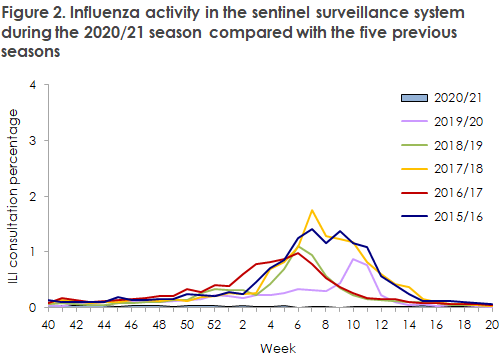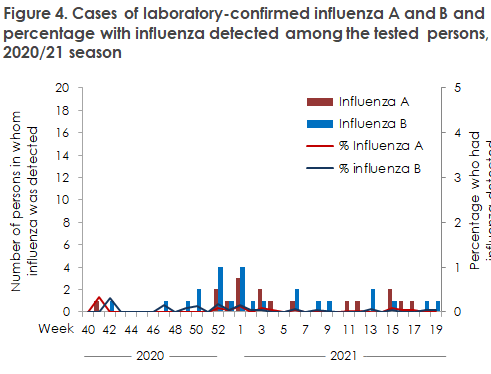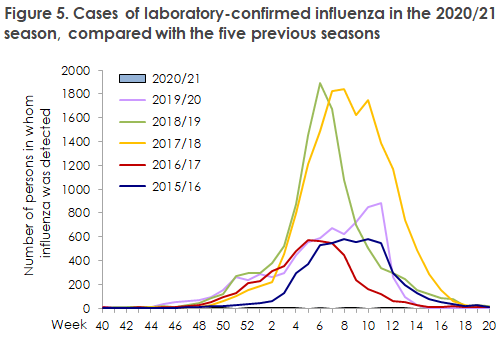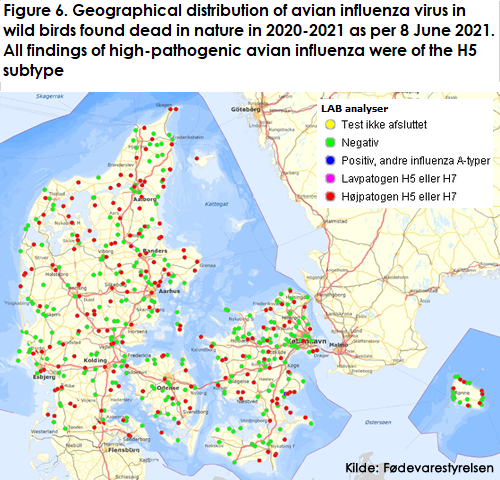No 22/24 - 2021
The 2020/2021 influenza season - report on disease occurrence
The 2020/2021 influenza season - report on disease occurrence
The 2020/2021 influenza season was completely unusual. In fact, it never started. The persistent fight against COVID-19 as from the spring of 2020, including hygiene measures, restrictions, limits on public gatherings, etc. in the Danish society meant that the usual increase in influenza and other airway infections in winter was essentially absent.
The same phenomenon was observed in other European countries and in the Southern Hemisphere during their winter season. Additionally, highly limited travel activity has reduced the spread of influenza.
Furthermore, the 2020/21 season was special because of the high coverage of the year’s influenza vaccination among persons aged 65 years or more, which reached 75%. In the past ten years, the coverage in Denmark has been approx. 50%. Thus, for the first time ever, Denmark has met the WHO’s recommendation that at least 75% of the population aged 65 years or more is vaccinated against influenza ahead of each new season.
In contrast to the few observed cases in humans in the 2020/21 season, an unusually high occurrence of avian influenza was seen in Danish birds. Thus, highly pathogenic influenza H5N8 was detected in 337 wild birds and in 15 bird keeps. Similarly, various other North and East European countries were heavily affected by avian influenza in this season.
This week’s EPI-NEWS summarises the most important details from the year’s influenza season, whereas a more comprehensive description of the influenza occurrence and the surveillance methods employed is available in the 2020/21 Annual Report on Influenza.
Influenza occurrence
Thus, throughout the entire 2020/2021 season, only 46 cases of influenza were detected among 69,913 tested samples. For comparison, the 2019/2020 season recorded 7,575 positives among 68,530 tested samples.
Among the detected influenza cases, approximately equal proportions were seen of influenza A and B. The number of positive samples sent for typing was so low that it is not possible to draw any general conclusions about the subtype in circulation.
The proportion of patients who contacted their GP for ILI is presented in Figure 1. In the autumn, as from Week 40 and until the turn of year, the ILI share was lower than expected but then decreased further to a very low level, which was sustained for the rest of the season. It should be noted that ILI activity primarily reflects the occurrence of COVID-19, and the curve therefore documents the relatively extensive COVID-19 transmission that occurred in Denmark in November-December, which then largely came under control from January onwards thanks to the intensified restrictions and lock-downs imposed on the Danish society.

In the surveillance of the emergency call service physicians, the consultation percentage recorded in the entire 2020/21 season was also extremely low compared with previous seasons, Figure 2.

Among the season’s approx. 15,000 influmeter participants, approx. 8,000 persons reported their symptoms weekly from October 2020 to May 2021. A total of 2,040 persons were registered with ILI among the season’s participants. Throughout the season, the proportion of participants with ILI remained low (between 1% and 2%), Figure 3.

Laboratory-confirmed influenza
MiBa data extraction showed that a total of 69,913 patients were tested for influenza from Week 40 in 2020 to Week 20 in 2021. In all, 46 hereof tested positive to influenza (0.07% of those tested); 19 to influenza A and 27 to influenza B, Figure 4. For comparison, the 2019/2020 season recorded 7,575 positives among 68,530 tested samples (11%). The extraordinarily low number of detected influenza virus cases demonstrates that this influenza season essentially never happened. The low occurrence cannot be explained by less influenza testing than normally. In fact, more people were tested than in the previous season.

The number of detected influenza samples in 2020/21 compared with the five previous seasons is presented in Figure 5.

In the course of the 2020/21 season, the National Danish WHO Influenza Centre at Statens Serum Institut (SSI) received samples from a total of 279 patients for testing and characterisation of influenza virus, including 121 samples submitted by sentinel physicians. The remaining samples were submitted as diagnostic samples or by other laboratories, of which 11 originated from departments of clinical microbiology. During the course of the season, it was possible to confirm influenza A only in a single sample. This sample contained a special virus variant of the N1H1v subtype that was more closely related to virus circulating in pigs than humans. No further cases were detected of the special virus variant in relation to the finding, which is therefore considered an isolated case. Also see this news article.
Influenza-related hospital admissions and mortality
Because of the very low influenza occurrence and the spread of COVID-19, weekly analyses were not made of influenza-related hospital admissions to intensive care units or influenza-related mortality.
The general excess mortality in the population was calculated weekly. After Week 26, 2021, an overall analysis of the winter season will be prepared as usual. This analysis, however, will primarily reflect mortality related to COVID-19, given the absence of influenza and other common respiratory infections. The SSI has established a new sub page to SSI.dk that provides a detailed description and analyses the mortality in the Danish population on a week-by-week basis.
Vaccination coverage among risk groups and vaccine effectiveness
Seasonal influenza vaccination was offered free of charge to persons with an increased risk of running a serious influenza course in the period from 1 October 2020 through 15 January 2021 and to pregnant women in their second and third trimesters and persons with immune deficiency and their contacts until 1 March 2021, EPI-NEWS 44/20. Furthermore, for the first time ever, vaccination was offered free of charge to public healthcare and nursing staff. In the 2020/21 season, 4-valent inactivated influenza vaccines that protect against two types of influenza A and two types of influenza B were used in most risk groups. The oldest citizens aged 85 years or more were offered a high-dose vaccine for the first time ever.
A total of 1,339,014 were registered as having been administered in 2020/21. Hereof, 879,168 vaccines were given to elderly people aged 65 years or more, corresponding to a 75% vaccination coverage in this group. This is much higher than the previous years, when the vaccination coverage in this group was 52%. This may be owed to enhanced awareness in the group of the risk of serious illness due to influenza or in case of double infection with influenza and COVID. Furthermore, for the first time, all citizens aged 65 years or more received an influenza vaccination reminder either in their e-Boks or by letter from the SSI. It should be mentioned that administrative changes have been introduced in the service codes used for risk groups in the 2019 season, and therefore it is difficult to directly compare with previous seasons the vaccination coverage of persons aged less than 65 years with chronic disease and early retirement pensioners.
Influenza vaccine effectiveness (VE) is normally calculated both at the mid-point of the season and once the season has concluded. Because of the very low number of influenza cases, it has not been possible to calculate VE for the 2020/21 season.
Avian influenza outbreak in Denmark
Since the autumn of 2020, a highly pathogenic avian influenza (HPAI) has caused disease and increased mortality among wild birds and in bird keeps in Denmark and in various other countries. The outbreak was prolonged, but in a threat assessment published on 24 May 2021, the Danish Veterinary and Food Administration assessed that the overall risk of transmission of highly pathogenic avian influenza to Danish bird keeps may be lowered from High to Low. Sporadic findings in wild birds are still to be expected.
Since the outbreak started, highly pathogenic avian influenza has been detected in 337 wild birds that have been found dead in nature. Primarily clade 2.3.4.4b H5N8 avian influenza was detected, but a limited number of cases were detected of related viruses of subtypes H5N5, H5N3 and H5N1.

In the same period, avian influenza caused outbreaks with HPAI H5 in large commercial bird flocks, leisure time keeps and other captive birds. A total of 15 flocks in Jutland and on Zealand, Langeland and Bornholm were affected. In 14 of these flocks, virus of the subtype H5N8 was detected, whereas one was affected by H5N5. In all cases, the viruses detected were closely related to viruses detected in dead wild birds.
Avian influenza in humans in Russia
In February 2021, the World Health Organization (WHO) reported that several human cases of avian influenza H5N8 had been detected in Russia. Thus, in connection with an H5N8 outbreak in a large bird flock, H5N8 virus was detected in seven workers, all of whom were involved in the culling and handling of dead, diseased birds. The seven persons had none or only mild symptoms even though they are believed to have been exposed to large amounts of virus. Subsequently, person-to-person transmission was not detected, and the WHO assessed that the infection risk for humans was low.
(The SSI Influenza Team: L.S. Vestergaard, L.K. Knudsen, H.-D. Emborg, N.U. Friis, C. Kjelsø, J. Nielsen, S.K. Vestergaard, H. Bang, Infectious Disease Epidemiology and Prevention, R. Trebbien, C.K. Hjulsager, Virology Surveillance and Research)